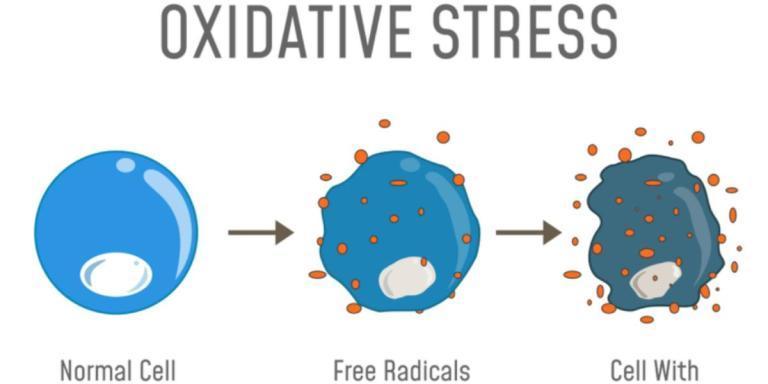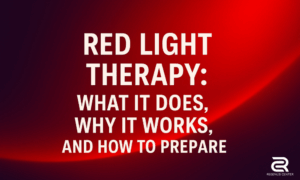Arguably, that oxidative stress is the original root cause is a convenient truth that immediately takes your attention off the actual cause. Meanwhile, the real cause of disease stays in place.
Let me explain.
Oxidative stress is a primary effect of the environment you live in, your lifestyle (including, but not limited to, the way you eat), and your stress levels; it’s not the original cause. In other words, you don’t wake up one day and start suffering from excessive oxidative stress and inflammation, as if it’s happening to you.
To be accurate, in some measures, it IS happening to you, as oxidative stress is a byproduct of stress and energy production. Still, your body is designed to handle that oxidative stress naturally. The body has its antioxidant defense system, and antioxidants occur naturally in your diet, assuming you eat such a healthy diet.
But suppose you live in an environment and in ways of life that increase oxidative stress and inflammation. In that case, those natural systems will be overrun, creating negative consequences from cellular disfunction to accelerated aging of the body.
That said, while what you eat is directly related to whether you will experience excessive oxidative stress, many will default to improving their diet as the primary method of reducing oxidative stress. Yet, a poor diet is not the only cause, and there are several elements of your lifestyle that will affect oxidative stress and inflammation.
So before we dive deeper into the three primary ways to reduce oxidative stress and inflammation, the main thing is to keep the “main thing” the main thing.
Your environment, your lifestyle, and the overall volume of stress bearing down on you, as a whole, are always the primary causes of disease (genetics notwithstanding, and injury is not a disease), not oxidative stress and inflammation.
Both oxidative stress and inflammation are, at the same time, both a primary effect and a consequential cause of disease.
We share this with you first because it’s all too common for people to confuse the actual root cause with a primary or secondary “effect” of the original “root cause.” When we do this, it’s then easy to pursue all kinds of therapies to solve the problem with the actual root causes still in place.
The founders of Regenus Center are professional lifestyle coaches, so we are very privy to this insight.
The Definition
Oxidative stress is an imbalance of free radicals and antioxidants in the body, which leads to cell and tissue damage. Oxidative stress occurs naturally and plays a vital role in the aging process. Still, environmental factors such as pollution and aspects of your lifestyle like an eating style low in micronutrients or excessive or obsessive exercise, among several other stress factors, can seriously increase oxidative stress.
Almost everyone is familiar with antioxidants. Many supplement antioxidants in an otherwise micronutrient-poor diet, when what they need to be eating is more whole, plant-based, micro-nutrient-rich foods (antioxidants are included here) that aid the body’s antioxidant defense system.
According to Joel Fuhrman MD, aka Dr. Fuhrman:
Oxidation happens in all of our bodies as we process the oxygen we breathe, and our cells produce the energy we need from it. It is a chemical reaction in our body that also produces free radicals –molecules that can cause damage to our cells. Free radicals are required to some degree and cause some damage that stimulates repair. Only when too many free radicals are produced and overwhelm the repair processes it results in oxidative stress.
Free radicals include reactive oxygen species (ROS) and other molecules with unpaired electrons, making them unstable and highly reactive. Free radicals damage the molecules that make up our DNA, protein, and lipids (fats), which leads to tissue injury.
The body has innate antioxidant systems to counteract the effects of free radicals. However, when the cell’s antioxidant system is overwhelmed by the amount of ROS and other free radicals, this is the definition of “oxidative stress.” 1 Over many years, accumulated oxidative damage to our tissues contributes to the aging of our body and diseases, such as cancer, diabetes, and heart disease.2
In addition to some free radicals formed during cellular energy production, free radicals also develop due to environmental influences, such as cigarette smoke and excess UV radiation from sun exposure. A poor diet also increases exposure to free radicals.
So Here are Three Primary Ways to Reduce Oxidative Stress and Inflammation.
Here at Regenus Center, people often come in looking for a solution to oxidative stress and inflammation.
They are in the right place, but not just because we offer the best possible delivery of regenerative therapies (recovery) such as PEMF and Whole Body Photobiomulation (red and near-infrared light therapy), among other essential and complementary modalities as part of a protocol. They are in the right place because we help them clean up their environment and improve their lifestyle, including reducing and eliminating excess stress.
A natural cause of oxidative stress is a byproduct of energy production in the body. But what happens when our cells aren’t healthy? When we get stressed, sick, or injured, mitochondria in our cells can produce nitric oxide (NO) as part of cell defense, which is the other significant function of mitochondria outside of being the “powerhouses of the cell” where the processes of respiration and energy production occur.
To understand the ramification of that, we have to understand an enzyme called cytochrome c oxidase. During ATP synthase (the enzyme that ultimately produces ATP), nitric oxide competes with oxygen and binds to this enzyme. This competition stops or slows the production of ATP (the chemical currency of energy in the body) and thereby increases oxidative stress in the cell, leading to cell death.
So stressed cells produce nitric oxide (NO), which binds to cytochrome c oxidase and halts the production of ATP Synthase.
Regenus Center’s protocol is based on the three primary ways to reduce oxidative stress, which leads to inflammation. By “primary,” we mean even before you’ve had a chance to completely clean up your environment, improve your lifestyle, including nutrition, and reduce excessive stress.
Way #1:
Recharge the body, your cells, or your “body battery” using red, near-infrared light therapy.
In this excellent article on how red and near-infrared light stimulates cellular respiration and boost energy production, we learn that red and near-infrared light helps your body efficiently create ATP in the mitochondria. And in that process, it significantly reduces oxidative stress as it breaks the bond between nitric oxide and cytochrome c oxidase, which, if left in check during periods of stress, slows down energy production and increases oxidative stress.
Way #2.
The slew of environmental toxins to which we are exposed daily is a significant source of oxidative stress.
A patient’s living environment can be a substantial source of oxidative stress. Exposure to particulate air pollution in urban areas and mold and biotoxins in water-damaged buildings promotes oxidative stress by depleting antioxidant reserves. (11, 12) You can learn more about the harmful health effects of mold and biotoxins by reading my article “5 Things You Should Know About Toxic Mold Illness.”
Plastics are well known for their endocrine-disrupting effects. However, research suggests that plastics also induce oxidative stress. In the body’s attempts to detoxify BPA, a ubiquitous plastic chemical, free radicals are generated via activation of cytochrome P450 enzymes in the liver. The induction of free radicals and oxidative stress by BPA is believed to contribute significantly to the toxicity and carcinogenicity of this compound. (13).
Pesticides and heavy metals also provoke oxidative stress. Exposure to organophosphate insecticides (OPs), the residues of which can be found on conventionally grown fruits and vegetables, induces oxidative stress by activating cytochrome P450 enzymes and disturbing the cell redox system, which reduces cellular energy and makes cells unable to neutralize free radicals. (14)
Heavy metals, found in dental amalgams, air, and soil, and our water supply, induce oxidative stress by altering the activities of key antioxidant enzymes such as glutathione peroxidase, glutathione-s-transferase, superoxide dismutase, and catalase. (15)
Way #3:
Lifestyle Optimization – One of the vital features of a Regenus Center is that it offers a Lifestyle Coach – Live a Better Life!
Most people suffer to some degree or another from excess stress.
- Overexertion
- Pollution (unclean environment, including smoking, etc.)
- Micronutrient poor diet
- Obsessive exercise
- Overwhelming and unhealthy lifestyle, including psychological stress.
- Too much pressure is bearing down on them from the outside.
- Etc.
Lifestyle Coaching is basically about changing, improving, and optimizing the way you live so that 90% of the time or more, your lifestyle is working for you, not against you. In other words, based on the fundamentals of energy, health, and performance, you want to align the way you live with these fundies to prevent the long list above from impacting and cutting our lives short.
The primary purpose of every aspect of your lifestyle is first and foremost to help you manage your energy, maintain your health, and function fully so that you can perform well and achieve your goals with quality of life in the process.
But most people have no idea what the fundamentals are and fall prey to market forces that keep them confused and, in so many cases suffering from oxidative damage from excess stress. You can learn more about what they are at Lifestyle Coach; in a blueprint that will save you up to 20 years or more.
——————————-
As “client zero,” Professional Lifestyle Coach John Allen Mollenhauer, known as John Allen or by his initials “JAM,” was desperate to figure out how to achieve his goals without burning out and trading his health for success despite being proficient in nutrition and fitness.
As a result, over 20 years, he made the most significant lifestyle change one can make, learned how to manage his energy, and step by step produced the never-before-assembled formula for living a balanced and healthy high-performance lifestyle. Today, he’s still an in-the-game lifestyle entrepreneur as the founder of RegenUs Centers and a pioneering Performance Lifestyle® Coach.
He is the founder of Lifestylecoachjam.com, where subscribers discover how to achieve even their most ambitious goals while living in balance with vibrant health and peace of mind. Set yourself up for a new kind of success, and develop a healthy, high-performance lifestyle you can call your own.
General Disclaimer: These services are not intended to diagnose, treat, cure or prevent any disease. This Website offers health and fitness advice. This advice is designed for educational purposes only and is not intended to replace the advice, treatment, or diagnosis of a healthcare professional. Always consult your physician before beginning any therapy program. You agree that you assume all responsibility when choosing to act on any of the health or fitness advice contained on this Website. We reserve the right to amend this policy at any time without any prior notice to you.





